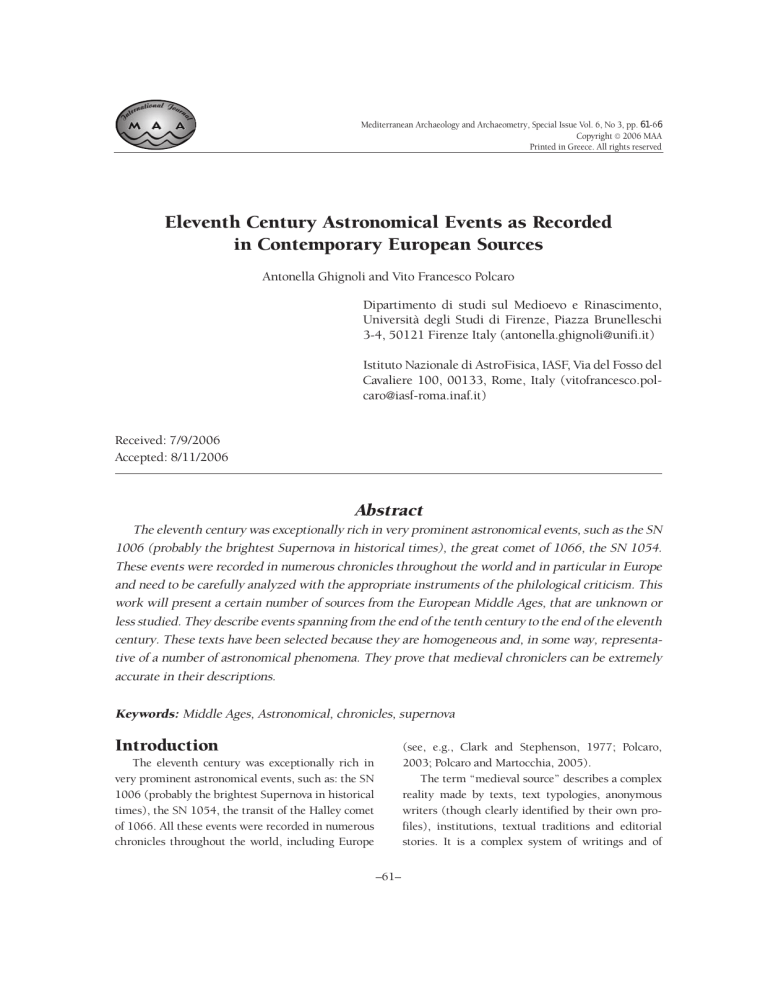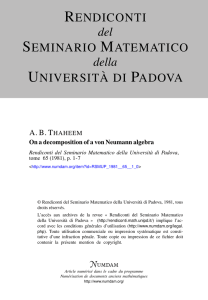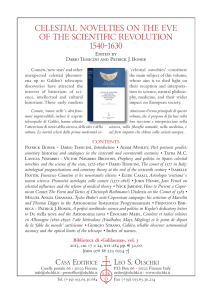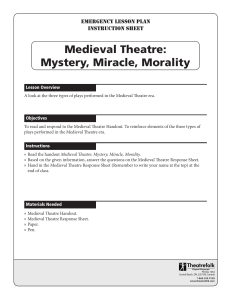caricato da
alb_it
11th Century Astronomy: European Records of Supernovae & Comets

Mediterranean Archaeology and Archaeometry, Special Issue Vol. 6, No 3, pp. 61-66 Copyright © 2006 MAA Printed in Greece. All rights reserved Eleventh Century Astronomical Events as Recorded in Contemporary European Sources Antonella Ghignoli and Vito Francesco Polcaro Dipartimento di studi sul Medioevo e Rinascimento, Università degli Studi di Firenze, Piazza Brunelleschi 3-4, 50121 Firenze Italy ([email protected]) Istituto Nazionale di AstroFisica, IASF, Via del Fosso del Cavaliere 100, 00133, Rome, Italy ([email protected]) Received: 7/9/2006 Accepted: 8/11/2006 Abstract The eleventh century was exceptionally rich in very prominent astronomical events, such as the SN 1006 (probably the brightest Supernova in historical times), the great comet of 1066, the SN 1054. These events were recorded in numerous chronicles throughout the world and in particular in Europe and need to be carefully analyzed with the appropriate instruments of the philological criticism. This work will present a certain number of sources from the European Middle Ages, that are unknown or less studied. They describe events spanning from the end of the tenth century to the end of the eleventh century. These texts have been selected because they are homogeneous and, in some way, representative of a number of astronomical phenomena. They prove that medieval chroniclers can be extremely accurate in their descriptions. Keywords: Middle Ages, Astronomical, chronicles, supernova Introduction (see, e.g., Clark and Stephenson, 1977; Polcaro, 2003; Polcaro and Martocchia, 2005). The term “medieval source” describes a complex reality made by texts, text typologies, anonymous writers (though clearly identified by their own profiles), institutions, textual traditions and editorial stories. It is a complex system of writings and of The eleventh century was exceptionally rich in very prominent astronomical events, such as: the SN 1006 (probably the brightest Supernova in historical times), the SN 1054, the transit of the Halley comet of 1066. All these events were recorded in numerous chronicles throughout the world, including Europe –61– Antonella Ghignoli and Vito Francesco Polcaro memorandumque posteris signum, stella videlicet perlucida in ipso partium conflictu medio coeli axe, media ultra morem die, quasi divinum regi capto praebitura iuvamen, cunctis, qui aderant, cernentibus stupendibusque radiavit.” “Once this very important meeting ended in that place, there was a sign, that excited wonder, worth to be remembered by posterity: a very bright star – [that appeared] on that axis that joins in the middle the parts of the sky at midday and thus beyond every natural order – shone over all those present – that could see it and were astonished –, as if it were a sign of the future help offered by God to the king” The translation of “in ipso partium conflictu medio coeli axe” may also be “on this axis arranging in the middle the parts of the sky”, if “conflictu” is an error of the copyist to be read “confictu”. The phenomenon is reported during a celebrated “concilium” held in Rohr, near Meiningen, at the presence of the Empress Theophanu, regent for the baby Otto III, of the same abbess of Quedlingburg, Matilda, and of an enormous number of noblemen coming from various regions of the empire. This concilium started on June 29th 984, as it is attested by juridical documents, in order to discuss a delicate political problem (the Infant Otto III and his mother were opposed by the powerful Bishop of Magdeburg). The concilia lasted usually many days. The June 29th must thus be considered a “terminus post quem”. The “Annales” were started by a chronicler who was a monk (or, most probably, a nun) around 1008. He (or she) draws from previous original and autograph texts the event preceding the year 1003, while he wrote from his own experience the history of the following events till the year 1030, when the chronicle is closed (see Die Annales Quedlinburgenses, p. 47 ss.). Apart from the final reference (“quasi divinum regi capto praebitura iuvamen”), the text can thus be assumed as a testimony. But the nature of the reported phenomenon is far from clear. No entries are reported by the Ho Peng Yoke (1962) list of astronomical events in Eastern chronicles for the year 984. A single event (most probably a world visions in writing of the “history” (personal history, history of the own monastery, history of the World, history of a saint), that need to be carefully analyzed with appropriate instruments: first of all, the concepts of philology and the method of historical criticism. Reading these texts is a complex experience. The simple (and maybe stereotyped) idea of “medieval mentality” cannot serve as a rule, mainly when it is necessary to extract from these texts astronomical information, to be compared with our present day “objective” astronomical knowledge, both observational and theoretical. In particular, a renewed study, taking into account this complexity, will need for the known medieval western sources concerning eleventh century Supernovae: the SN 1006 and of SN 1054 events play in fact an important role in modern astrophysics and the eastern ancient sources contain uncertain and problematical assertions about them (see, e.g. Polcaro, 2005). This work will present for now a series of unknown or neglected medieval western sources, that describe astronomical (and, in one case, meteorological) events spanning from the end of the tenth century to the end of eleventh century. The selected texts are of the same typology: “Annales” and chronicles, but redacted in the eleventh century. The two typologies – annales and chronicae -, that are very different in the previous period, became very similar and nearly coincident just in this century (see McCormick, 1975). The selected texts are homogeneous and do not present critical problems relating to the authorship and to their tradition or thorny questions of authenticity. They can be used for historical astronomy purposes and their reading is comparatively ‘easy’. A “bright star” at noon at the end of the 10th century The Annales Quedlinburgenses report for the year 984 (no precise indication of the day is given): ”Habitoque inibi consilio maximo mirandum –62– ELEVENTH CENTURY ASTRONOMICAL EVENTS AS RECORDED IN CONTEMPORARY EUROPEAN SOURCES circulus magnus circa solem colorem iris habens, quem alii quatuor lucidiores circuli binis loris in modum crucis complexi sunt; attamen tribus rarescentibus duo, id est medius et aquilonaris, diutissime perstiterunt.” “Then on July 18th a Monday 23rd moon at the beginning of the 3rd hour of the day, till after the 6th, a large circle surrounding the sun appeared with the color of the rainbow; other four brighter circles embraced it with two strings from both sides forming a cross; while three of them were vanishing, the other two – the central and the southern one – lasted for a very long time” First of all, we notice that no other contemporary source reports this phenomenon. It is congruent: the preceding description referred clearly to a parhelion, a meteorological phenomenon, that is strictly local. The precision in the report of the date (new moon was in fact on June 26th) and duration of the phenomenon is however rather remarkable: it is explicit (incipiente hora diei III usque post VII) and consciously recorded (diutissime perstiterunt). comet) is reported on April 3rd 983, but this date is by far too different to be associated with the previously reported phenomenon. Only Newton (1972), to our knowledge, studied this passage of the Annales Quedlinburgenses from an astronomical point of view and considered it as a witnesses of a Nova. But this hypothesis seems us unlikely, since it is very difficult that a nova could be so bright to be seen in day light. The duration of the phenomenon is not recorded, but it seems to have been short, since it is connected just with the end of the “concilium”. Its luminosity must have been very high, since it was visible at noon. The most likely hypothesis is thus a meteorite fall, though no record is made of sounds or of a rapid movement. Another, more exotic, possibility is a far away Supernova, many order of magnitude brighter than a nova, visible just on the first peak immediately following the explosion (see, e.g. Wang, 2005). In this case, the conjunction with the Sun, masking the following evolution till the decline under the naked eye visibility, could easily explain the lack of other records. The unreliable information given by this passage is however scanty to be useful for astrophysical purpose. On the other hand this is not the most common case. A new star in the Big Dipper? Thietmar, Bishop of Merseburg, is a very good historiographer, author of a chronicle accounting the years of his duty and the years immediately preceding it, between 912 and 1018 (see Die Chronik des Bischofs Thietmar). Here is how he tell us what he saw, as a direct spectator, on August 1018 (p. 516, 5): “In diebus illis in episcopatu meo septem mancipia fungos manducavere non rectos et acri ardore succensi celeriter mortui sunt. Et in mense augusti stella quedam iuxta plaustrum noviter apparens radiis eminus emissis cunctos cernentes terruit. Numquam enim nostri memoria talis exoritur et ideo unusquisque hoc admiratur”. (”In these days, during my episcopate, seven servants eaten bad mushrooms and then dead with burning sensation. And in the month of August, a new star, that appeared near to the Wagon, terrified with its long rays all the spectators. Never, to our memory, rays as such appeared and thus everyone was astonished”) Another manuscript of the chronicle of Thietmar A Perihelion on 1020 Let consult again our chronicler of the Quedlinburg Abbey at the pages dedicated to the year 1020. This time, he/she refers a phenomenon seen by person, because of the considerations previously made on the time of composition. The description is actually perfect and precise and the phenomenon is exactly sited in time (month, day and hour), on the contrary of the “stella” described in the framework of the 984 Rohr concilium. The narrator is a direct witness, on duty as annalist of the Abbey and he/she records the experience in an excellent way. “Deinde in XV Calend. August., feria II, luna XXIII, incipiente hora diei III usque post VI, apparuit –63– Antonella Ghignoli and Vito Francesco Polcaro (that is, in any case, an ancient and authoritative witness of its tradition, in which no original is preserved), reports a slightly variant version: “In diebus hiis in episcopatu meo septem mancipia (...). In mense Augusto stella quedam iuxta signum maioris urse quod vulgo plaustrum dicitur, noviter apparens radiis eminus emissis omnes cerntentes terruit. Numquam enim (...)” ” In these days, during my episcopate, seven servants (...). In the month of August, a new star, that appeared near to the constellation of the Big Dipper, that people call the Wagon, terrified with its long rays all the spectators. Never in fact, (...).” Asian (Japanese and Korean) chronicles report a bright comet in August 1018. Their descriptions are astonishingly similar to the Thietmar one. The 1033 eclipse referred by Bernold as computed by the famous astronomer Hermann the Cripple is reported in the Chronicon of the same Hermann (see Borst 1984). For the eclipse referred by Bernold in the year 1093, the same day is recorded by the Frutolf chronicle: Eclypsis solis facta est VIIII. Kalendas octobris hora tercia (Frutolfi et Ekkeardi Chronica, p. 106). The day would be September 24 according to the Annales Augustani (Annales Augustani, p. 134): Solis eclipsis in meridie in Libra, VIII Kalendas Octobris. The right date is September 23, 1093, at 09:08 UT: at that time the Sun was however in Balance, as reported by the Annales Augustani. Concerning comets, Meyer von Knonau (18901904: vol. 1, p. 523) asserted, that the German chronicles contain numerous and variant versions of the transit of the Halley comet in 1066. It is true. But this is in no way a proof of systematic “lack of precision” of the observers. On the contrary, it could be a proof of their attention to details, since it is well known that a comet can change its appearance and its position in the sky on a very short time scale. It is shown, for example, by the records of the Halley transit in the Annales Althaenses and in the chronicle of Berthold of Reichenau. Annales Althaenses (Annales Altahenses maiores, p. 71): ”Tribus proximis diebus ante Pascha per totam Italiam stella quaedam mirae magnitudinis apparebat, quae radium unum in modum hastae versus orientem mittebat. Post Pascha autem in diebus rogationum non per Italiam solum, sed iam per totum regnum stella cometa apparuit et per quatuordecim dies magno miraculo intuentibus fuit.” ”Three days before Easter, in the whole Italy appeared a star of extraordinary greatness, that issued a single ray, like a spear pointing East. After Easter, in the days of the Rogations [22-24th May] the comet was seen not only in Italy but in the whole Kingdom and it was a great wonder to observe for fourteen days” The Annales, concerning the years from 1033 till 1073, were written by a single author and in a rela- “Normal phenomena”: Eclipses and comets Actually, the records of comets, as well as those of Sun and Moon eclipses are frequently and precisely (from our point of view) reported by annalists: therefore, they are considered as “normal cases”. This is an example of eclipse, reported by Bernold of Konstanz for the year 1093 (Die Chroniken Bertholds von Reichenau und Bernolds von Konstanz, p. 505): ”Signum in sole factum est VIIII. Kal. Octobris ante meridiem, ut circulus quidam in illo appareret et ipse in sereno celo obscurissime luceret. Sed hoc magis quidam eclipsin quam signum fuisse putaverunt, praecipue cum luna est XXVIIIa ea die. Nam egregius calculator domnus Heremannus etiam in XXaVIIa luna eclipsin accidisse scribit anno Domini MXXXÆIIIÆ.” ”On September 23 before noon, a sign was seen in the Sun: a circle appeared around it and it [the circle] shone in the sky, wich was limpid and very dark. Some people believed however that it was an eclipse rather than a sign, because the Moon was in its 28th day. The great mathematician Hermann asserts that in 1033 an eclipse happened also in the 27th day of the Moon” –64– ELEVENTH CENTURY ASTRONOMICAL EVENTS AS RECORDED IN CONTEMPORARY EUROPEAN SOURCES of April [the 4th April], the wednesday after the Octave of Easter, from the end of the night [the ‘vigilia’ is the fourth part of the night] till the dawn, innumerable stars were seen to fall from the western part of sky everywhere ”. [4 apr. 1123] “Hoc interea tempore anno dominice incarnationis eius millesimo centesimo vicesimo secundo pridie nonas Aprilis quarta vigilia noctis, cum fratres nocturnalem synaxim decanterent, stelle de celo innumerabiles cadere et quasi pluere vise sunt ubique per totum orbe terrarum.” ([4 apr. 1123] “In that time, in the year 1123, the day before the nonas of April [the 4th April], at the end of the night, while the brothers were singing together the divine office of the night, innumerable stars were seen to fall as a rain from the sky over the whole World”. The phenomenon, that the chronicle describes in both passages, is without doubt a meteoric shower, that could be also identified with the h Aquaridis, connected with the orbit of the Halley comet. This kind of phenomena happen often in the same dates. So it is possible that the repetition here is not a simply ‘accident’ of the composition of the text, on the contrary the iterated description (in a ‘standard’ language) of a phenomenon, that could be happened in the same day of different years. Furthermore, when the periodic meteoric showers are strong, they are seen commonly on very wide areas: the expression “over the whole World” could have a real meaning. tively short lapse of time, around the year 1075. The author was a monk, who lived in Italy. We have not the autograph; the text is preserved nevertheless in a very ancient copy, strictly connected with the lost original. In 1066 Easter was on April 16: according to this text, the comet was therefore visible in Italy starting on April 13; in the Regnum (that is in Germany) it was seen in the following weeks. Actually, the position of the Halley Comet in 1066 transit moved from S to N: it was therefore visible first in Italy and then in Germany. The same transit is recorded in a perfectly consistent way in the Chronicle of Berthold of Reichenau, who states (Die Chroniken Bertholds von Reichenau und Bernolds von Konstanz, p. 202): “Comete sunt vise in octavis Pasche, id est VIIII. Kal. Maii, et per dies XXX duraverunt.” ”Comets are seen during the octave of Easter, that is. on April 23, and they lasted thirty days” The date is April 23: in 1066 that day was the “octave” of Easter, that is the “Sunday in albis”. A “Repeated phenomenon”? The Chronicle of Montecassino give us an example of a problem that is relatively common with the medieval texts. Nevertheless it could be simple to solve in this case. A certain phenomenon is recorded for the year 1095 (Die Chronik von Montecassino, p. 475). A similar description of a same phenomenon returns also for the year 1123 (p. 544). The coincidence of the day and the almost literal repetition of a number of expressions could be valid clues to think that the same passage (that is the same phenomenon) was written simply twice in the text of the chronic. [4 apr. 1095] “Anno autem dominice incarnationis millesimo nonagesimo quinto, indictione tertia, pridie nonas Aprilis, quarta feria post octava pasche a quarta ferme vigilia noctis usque in crepusculum stelle innumerabiles de celo versus occidentalem plagam ubique terrarum cadere vise sunt”. ([4 apr. 1095] “In the year 1095, 3rd indiction, the day before the nonas Conclusion Medieval western chroniclers and annalists were not expert in Astronomy like the Eastern. It is indeed true that writing chronicles had a quite different aim in medieval Europe in comparison with the Eastern countries. But they could not be defined “rough”, as it is too often stated by the Historical Astronomy scholars. When they observe a relatively “common phenomenon” such as a parhelion or an eclipse or a comet or a meteoric shower, they are precise in their descriptions. –65– Antonella Ghignoli and Vito Francesco Polcaro Instead, when they have to deal with an “unusual phenomenon” – outside from their expertise such as a Supernova or the fall of a meteorite –, it is more difficult for them to describe it in their ‘Latin’ (as standard and conventional written language), with common words or usual tropes. And we need much more critical effort to interpret their descriptions. Such an effort is for example indispensable by ‘reading’ records of eleventh century Supernovae in medieval western sources, that we will present in a forthcoming paper. Frutolfi et Ekkeardi Chronica necnon Anonymi Chronica imperatorum (1972) hrsg. von F.-J. Schmale und I. Schmale-Ott (Ausgewählte Quellen zur deustchen Geschichte des Mittelalters, 15). Ho Peng Yoke (1962) Vistas in Astronomy, 451, 127. Meyer von Knonau G., (1890-1904) Jahrbücher des Deutschen Reiches unter Heinrich IV. und Heinrich V., 1-5, Leipzig. McCormick M., (1975) Les Annales du haut moyen âge, Turnhout (Typologie des sources du moyen âge occidental; 14). Newton R.,(1972) Medieval Chronicles and the Rotation of the Earth, Baltimore and London. Acknowledgements Polcaro V. F.(2003) Le supernovae dell'XI secolo, Proc. of the 3rd SIA Congress, Naples. We thank David Beneteau (Seton Hall University, NJ) for critical reading and language revision of this paper. Polcaro V. F., (2005) The “Astronomical Bureau” during the Song Dynasty, Proc. of the SEAC 2005 Conference “Lights and Shadows in Cultural Astronomy”, June 28 - July 3rd, 2005, Isili, Sardinia, Italy. Polcaro V. F., Martocchia A., (2005) Supernovae astro- References physics from Middle Age documents, Proc of IAU Symposium 230 “Populations of High Energy Sources in Galaxies”, Dublin, Ireland, E. J. A. Meurs and G. Fabbiano (eds) Cambridge, Cambridge University Press, p.264. Wang Z.-R. (2006) Impact of historical Chinese astronomical records on high-energy sources in our Galaxy. In Annales Altahenses maiores (1891) hrsg. von E. von Oefele, Hannover, rist. 1997 (MGH, Scriptores rerum Germanicarum in usum scholarum separatim editi; IV). Annales Augustani (1839) hrsg. von G. H. Pertz, Hannover, (MGH, Scriptores, III), pp. 123-136. Die Annales Quedlinburgenses (2004) hrsg. von M. Giesl, Hannover (MGH, Scriptores rerum germanicarum in usu scholarum separatim editi; LXXII). Borst A., (1984) Ein Forschungsbericht Hermmans des Lahmen. In «Deutsches Archiv für Erforschung des “Populations of High Energy Sources in Galaxies”, Dublin, Ireland, E. J. A. Meurs and G. Fabbiano (eds) Cambridge, Cambridge University Press, 259-263. Mittelalters», 40, pp. 379-477. Clark D. H. and Stephenson F. R., (1977) The Historical Supernovae, Pergamon Press, Oxford. Die Chronik des Bischofs Thietmar von Merseburg und ihre korveier Überarbeitung (1935) hrsg. R. Holtzmann, Berlin (MGH, Scriptores rerum germanicarum, nova series, IX). Die Chroniken Bertholds von Reichenau und Bernolds von Konstanz. 1054-1100 (2003) hrsg. von I. S. Robinson, Hannover (Monumenta Germaniae Historica, Scriptores rerum germanicarum, nova series; XIV). Die Chronik von Montecassino (1980) hrsg. von H. Hoffmann, Hannover (MGH, Scriptores, XXXIV). –66–


